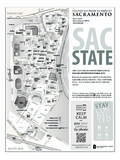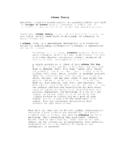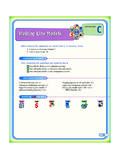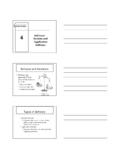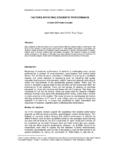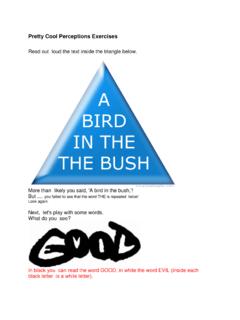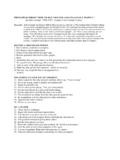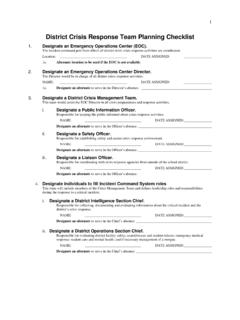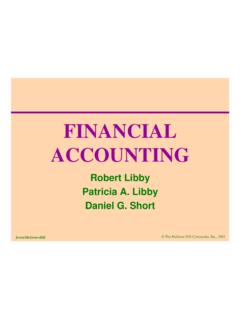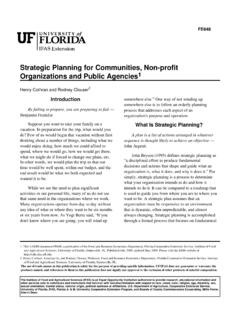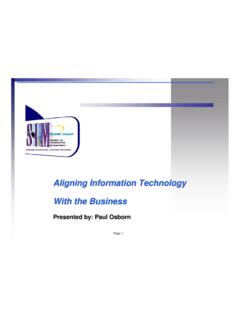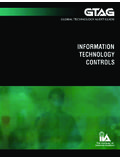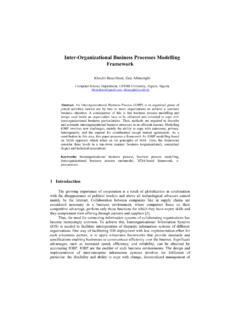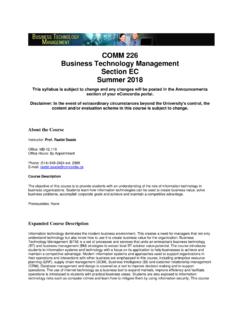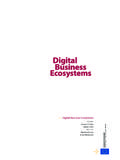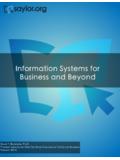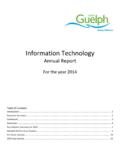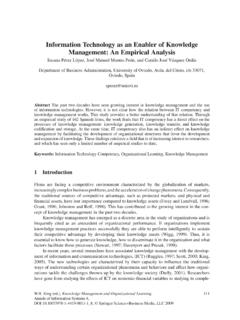Transcription of Business and Information Process Rules, Risks, and …
1 Business and Information Process Rules, Risks, and ControlsInternal Control Systems Internal controls encompass a set of rules, policies, and procedures an organization implements to provide reasonable th tassurance that: (a) its financial reports are reliable, (b) its operations are effective and efficient, and (c) its activities comply with applicable laws and regulations. These represent the three main objectives of the internal control system. The organization's board of directors, management, and other personnel are responsible for the internal control system. 1 Control Environment Control environment sets the tone of the organization, which influences the control consciousness of its people. This fd tiiddi i lid tthi h llfoundation provides discipline and structure upon which all other components of internal control are built. The control environment includes the following areas: Integrity and ethical behavior Commitment to competence Board of directors and audit committee participationMthilhdtitl Management philosophy and operating style Organization structure Assignment of authority and responsibility Human resource policies and practicesRisk Assessment Risk assessmentidentifies and analyzes the relevant risks associated with the organization achieving its objectives.
2 Risk assessment forms the basis for determining what risks need to be controlled and the controls required to manage Activities Control activitiesare the policies and procedures the organization uses to ensure that necessary actions are taken to minimize risks associated with achieving its objectives. Controls have various objectives and may be applied at various organizational and functional levels. Control Usage -Prevent, Detect, and Correct Preventive controlsfocus on preventing an error or irregularity. Detective controlsfocus on identifying when an error or irregularity has occurred. Corrective controlsfocus on recovering from, repairing the damage from, or minimizing the cost of an error or Activities Physical controlsinclude security over the assets themselves, limiting access to the assets to only authorized people and periodically reconciling theauthorized people, and periodically reconciling the quantities on hand with the quantities recorded in the organization s records.
3 Information processing controlsare used to check accuracy, completeness, and authorization of transactions. General controlscover data center operations, systems fiiidiidsoftware acquisition and maintenance, access security, and application systems development and maintenance. Application controlsapply to the processing of a specific application, like running a computer program to prepare employee's payroll checks each month. 3 Control Activities Performance Reviews Performance reviewsare any reviews ofPerformance reviewsare any reviews of an entity s performance. Some of the more common reviews: compare actual data to budgeted data or prior period data, operating data to financial data, and data within and across various units, subdivisions, or functional areas of the organization. Information and Communication The Information systemconsists of the methods and records used to record, maintain, and report the events of an entity, as ll tititbilit f thltdtwell as to maintain accountability for the related assets, liabilities, and equity.
4 Requirements: Identify and record all Business events on a timely basis. Describe each event in sufficient detail. Measure the proper monetary value of each Determine the time period in which events occurred. Present properly the events and related disclosures in the financial and Communication The communicationaspect of this component deals with providing an understanding of individual roles and ibilitit i it i tlt lresponsibilities pertaining to internal controls. People should understand how their activities relate to the work of others and how exceptionsshould be reported to higher levels of management. Open communication channelshelp insure that exceptions are reported and acted upon. Communication also includes the policy manuals, accounting manuals, and financial reporting manuals. Monitoring Monitoringis the Process of assessing the quality of internal control performance over time.
5 Monitoring involves assessing the design and operation of controls on a timely basis and taking corrective actions as needed. This Process is accomplished by ongoing monitoring activities by tthtitmanagement as they question reportsthat differ significantly from their knowledge of operations. 5 Control EnvironmentSub-elements of ControlEnvironmentAccountingSystemObject ives That Must Be SatisfiedControl ProceduresCategories of ControlProceduresTraditional Internal Control EnvironmentEnvironmentMust Be SatisfiedProcedures Management philosophy and operating style Organizational structure Audit Committee Methods to communicate the assignment of authority and responsibilityMttl Validity Authorization Completeness Valuation Classification Timing Posting and Adequate separation of duties Proper authorization of transactions and activities Adequate documents and records Physical control over assets and records Independent checks on Management control methods Internal Audit function Personnel policies and proceduressummarization Independent checks on performanceTraditional Control Philosophy Much of the traditional accounting and auditing control hilh hbbdth Duplicate recordingof
6 Accounting data and extensive reconciliation of the duplicate has been based on the following concepts and practices: Extensive use of hard-copy documentsto capture Information about accounting transactions, and frequent printoutsof intermediate processes as accounting transactions flthh thtip Accountantswho view their role primarily as one of independence, reactive, and detective. Heavy reliance on a year-end reviewof financial statements and extensive use of long checklists of required controls. Greater emphasis given tointernalflow through the accounting Process . Separation of duties and responsibilitiesso the work of one person checks the work of another person. Greater emphasis given to internal controlthan to operational efficiency. Avoidance or tolerancetoward advances in Information Control Concept #1 Accountantsmust become control consultants with a ltitit lThe perspective of people who develop and evaluate real-time, proactive, control philosophy that focuses first on preventing Business risks, then on detecting and correcting errors and evaluate the controlsControl Concept #2: Use modern IT to achieve the objectives of recording, itiidd iThe relationship between risks and specific tl maintaining, and producing outputs of accurate, complete, and timely Information by.
7 Evaluating the risksassociated with the updated mode of collecting, storing, control proceduresggand reporting data, and Designing specific control proceduresthat help control the risks applicable to the new Concept #3 Tailor control procedures to the Business processso as t ithlitf thThe ability to achieve control and reengineering to improve the quality of the internal control system while enhancing organizational objectivesControl Concept #4 Accountants must become familiar with IT capabilities dik di thThe relationship between Information and risks and recognize the opportunities IT provides to prevent, detect, and correct errors and irregularities as the Business events are and risk8 Control Concept #5 Processes that make extensive use of paper inputs and The complexity of Information pppoutputs and visible records of intermediate processes are not less risky than more "complex," highly-integrated systems.
8 "Complex integrated systems can be processingless riskyprovided they are properly constructed with the right controls built into Concept #6 An electronic audit trail is as effective as, or more ff tithbdThe need for visible informationeffective than, a paper based audit trail. The audit trail in an integrated, event-based system is often shorter and less complex than a traditionalthan a traditional paper based audit Concept #7 Be actively involved during the design and development tfdifi dThe time to design and implement tlstages of a new or modified Information system to help identify and implement controls into the Concept #8 Small organizations can have strong internal control tbittiThe size of the organizationsystems by integrating controls into the Information system and using IT to monitor and control the Business and Information an Updated Control Philosophy with an IT Perspective Hardcopy documents should largely be eliminated.
9 They are costly to both develop and maintain and they provide little benefit over an electronic version of the same Information . In fact, because of size, storage cost, and inaccessibility, paper documents are becoming a liability. Separation of duties continues to be a relevant concept, but IT can be used as a substitute for some of the functions normally assigned to a separate individualfunctions normally assigned to a separate individual. Much of the control that has been spread across several individuals can now be built into the Information system and monitored by Information an Updated Control Philosophy with an IT Perspective Duplicate recordings of Business event data and reconciliation should be eliminated. Recording and maintaining the duplicate data, and performing the reconciliation is costly and unnecessary in an IT environment. Accountants should become consultants with a real-time, proactive, control hldb l dti Much greater emphasis should be placed on preventing Business risks, than on detecting and correcting errors and an Updated Control Philosophy with an IT Perspective Greater emphasis must be placed on implementing controls during the design and development of Information systems and on more auditor involvement in verifying the accuracy of the systems themselves.
10 Although the annual audit of the financial statements will continue to be a valuable service performed by external auditors, its relative importance will diminish as greater importance is placed on verifying the accuracy of the systemimportance is placed on verifying the accuracy of the system itself and providing real-time reporting assurance an Updated Control Philosophy with an IT Perspective Greater emphasis must be placed on enhancing organizational effectiveness and controls must be adapted to maintain strong il linternal controls. This does away with the checklist mentality and requires an evaluation of specific risks and the creation of controls to address those specific risks. Information technology should be exploited to its fullest extent. This requires a concerted effort to understand both the capabilities and risks of IT. Modern IT should be used much more extensively to support decision processes, conduct Business events, perform Information processes, and prevent and detect errors and Process of Developing a System of Internal Controls If you develop a control philosophy based on the key control concepts identified in this chapter, the Process of developing an internal control system is rather straightforward: Identify the organization's objectives, processes, and risks and determine risk materiality.
